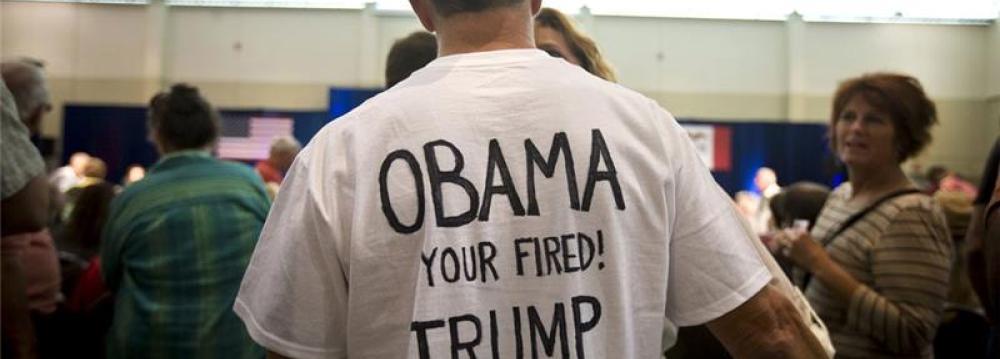Time Magazine’s August 31 cover featured US billionaire-cum-presidential hopeful Donald Trump with the caption: “Deal with it.” Jorge Ramos, the anchorman of the largest Latino TV network, had to “deal with it” during Trump’s press conference when he was bullied out of the room after asking the candidate a question concerning his dubious immigration proposals.
Remarkably, the assembled media did not come to Ramos’ defense, and the silence in the room was deafening as the leading Latino anchorman was tossed out of the room. Trump’s increasing hostility toward immigrants and Mexicans, in particular, those with the illegal distinction, are only a façade, Hatem Bazian wrote for Al Jazeera.
Trump’s entry into the presidential nomination contest witnessed an immediate assault on Mexican immigrants as the candidate bombastically proclaimed that Mexico is “sending people that have lots of problems, and they are bringing those problems to us. They are bringing drugs and bringing crime, and their rapists”.
Enter racial politics
Since the announcement of his candidacy in June, Trump continued battering Mexican Americans by using the derogatory term “anchor babies” to frame the immigration problem.
Trump is leading the Republican field by double-digits, and in some polls, by as much as 16 percentage points ahead of other Republican candidates. By launching the assault on Mexican immigrants, refusing to apologize and going after media personalities, he has tapped into a deep xenophobic and racist reservoir across the country.
While Trump’s stunning meteoric rise and domination of early polls has left many perplexed, nevertheless, this has to be seen as a culmination of a tide that began years ago.
What he has been able to do is to successfully, and in a very simple showman-style, ride an existing xenophobic and racist wave in today’s United States.
This new wave began to take shape immediately after the successful election of US President Barack Obama in 2008.
In many ways, Obama’s election in 2008 ushered the arrival of a new racial coalition into the heart of US’ political life–something that was profoundly unsettling for whites in the central and southern parts of the country.
The contestation around Obama’s birth certificate and his supposed “Muslimness” were utilized as a signpost for resurgent racist discourses that used distorted patriotic themes and “defense of country” as a rallying point against a supposed takeover of the US.
In the days and months after Obama’s victory, gun sales skyrocketed and the country witnessed the rapid rise of the Tea Party, which quickly degenerated into racism and xenophobic discourses.
Having lost the elections, a disastrous Iraq war and an economic collapse, mainstream and traditional Republicans were in no position to confront or challenge the new racist and xenophobic forces, and instead, opted to play along and ended up embracing the Tea Party.
The Republicans’ clasp of the Tea Party translated to success and the trouncing of the Democrats in the 2010 midterm elections, but it also pushed the party further into the racist fringe.
Thus, this fringe dominated the mainstream of the Republican Party, which was further edged by a set of insidious corporate and foreign policy interests.
Demonizing Obama
Right-wing media outlets, like Fox News, and radio talk shows magnified the Tea Party movement and helped it set the terms of xenophobic and racist debates.
The vehement opposition of Tea Party members and Republicans to Obama’s policies was more about what the president represented, and was an attempt to mount a “defense of whites”, who up until this point, constituted the numerical and political majority in the country.
Not being able to provide a cohesive response to demographic shifts, the Republicans opted to frustrate Obama and also demonize and delegitimize him in the eyes of the US public at every turn in the hope that they will be rewarded with a return to the White House.
In the years since Obama’s 2008 and 2012 election victories, the Tea Party and Republicans managed to break the psychological barrier on overt racism and xenophobia while casting white Americans as victims of a stolen country and facing financial ruin.
Thus, opposition to Obama’s policies and his skin color was instrumentalized by the right wing to sharpen overt anti-black racism, anti-Muslim rhetoric (Islamophobia), anti-Asian sentiments focused on China, and anti-Mexican xenophobia, while all along presenting whites as the “true American” cavalry coming out to the rescue.
Right-wing opportunism
Not being able to provide new ideas or expand a demographically shrinking base, the Republicans opted for a divide-and-conquer strategy by using racism and anti-immigrant rhetoric to achieve it.
Denying immigrants a path to citizenship translated to preventing further expansion of the Democratic Party voter base among new citizens. Similarly, dismantling the Voting Rights Act and incarceration are two tools to push African-American voters out of the voting booths across the country.
Trump understood the game better than those who set it up and turned the magic on the right-wing magicians by being more openly xenophobic and racist than anyone else and calling out the Republicans on the carpet publicly.
Trump has become the face of xenophobia and racism in the US today, but this will not be sufficient to win him the Republican nomination.
Throwing Jorge Ramos out of the press conference will reenergize millions of Latino voters, who will come out on election day to punish the Republicans, deny them the White House and end the Republican majority in Congress.


